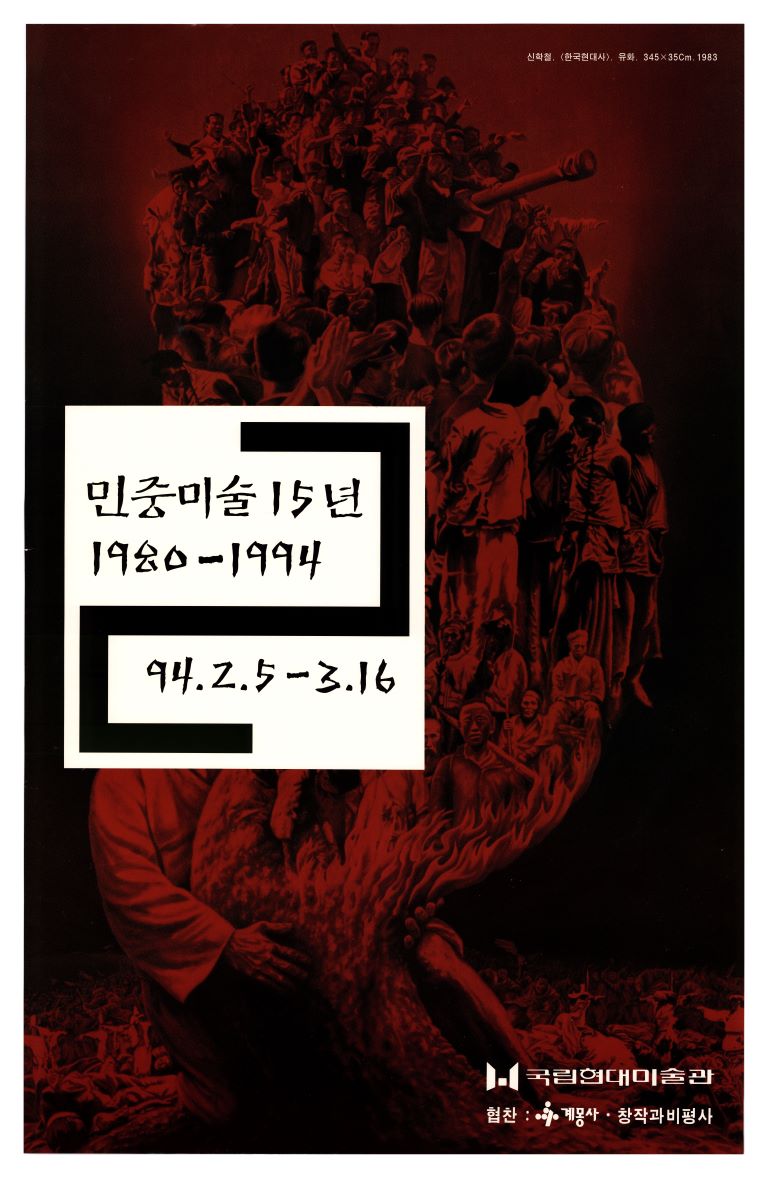
15 Years of Korean Minjoong Arts: 1980-1994, Exhibition poster, MMCA Art Research Center Collection
15 Years of Korean Minjoong Arts: 1980-1994
* Source: Multilingual Glossary of Korean Art. Korea Arts Management Service
Related
-
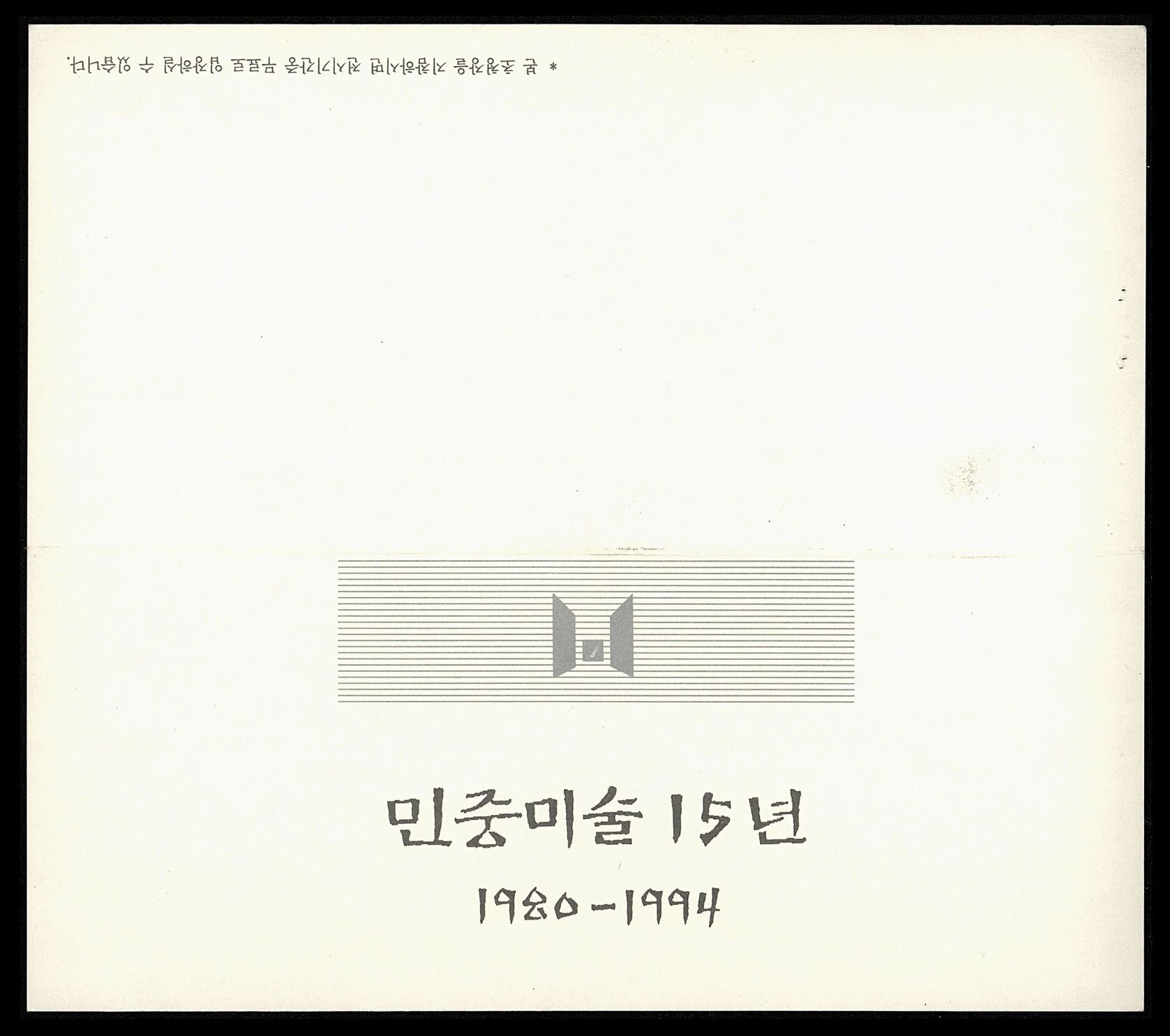
Minjung Art
An artistic movement that came to prominence alongside Korea’s democratization movement in the 1980s. Minjung artists often sought to critically portray the violent repression and corruption of the military dictatorship, to represent the experiences of laborers and farmers, and to achieve social change through art. In contrast to abstraction, which constituted the mainstream of 1970s art in Korea, Minjung Art is notable for the use of representational and figurative forms. One possible point of origin for Minjung Art is Oh Yoon’s work in the Reality Group (Hyeonsil dongin). The group was formed in 1969 by Kim Ji-ha, Oh Yoon, and Lim Se-taek. A variety of Minjung art groups were established, including the Reality and Utterance (Hyunsilgwa bareon) in 1979 by Kim Jungheun, Oh Yoon, Joo Jae-hwan, art critic Sung Wan-kyung, and Choi Min, the Gwangju Freedom Artist Association (Gwangju jayu misulin hyeopuihoe) in 1979 by Hong Sungdam and Choi Youl, the Imsulnyeon (The Year Imsul) in 1982, and the Dureong in 1983. These groups all commonly critiqued Western capitalism. In terms of form, Minjung artists adopted traditional and ethnic folk modes of expression using diverse media such as collage, printmaking, oil painting, and photography. Following the 15 Years of Korean Minjoong Arts: 1980-1994 Exhibition at the National Museum of Modern and Contemporary Art, Minjung Art became an accepted part of Korean art history. Overseas, Minjung Art has also become a recognized term that describes this genre and its unique focus on the political and social history of Korea.
-
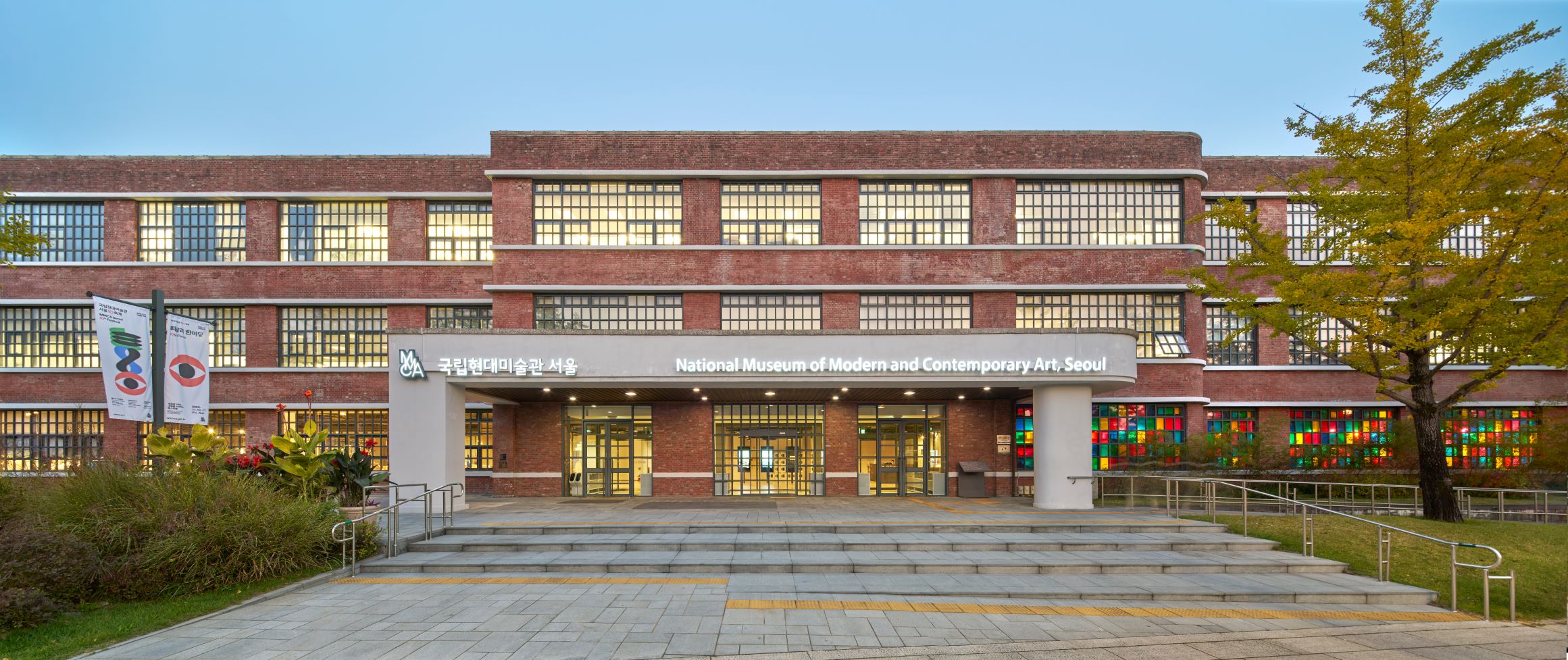
National Museum of Modern and Contemporary Art, Korea (MMCA)
A national museum established in 1969 that researches, collects, and exhibits modern and contemporary art. As of 2018, there are branches in Gwacheon, Deoksugung, Seoul, and Cheongju. When first established, the National Museum of Modern Art (now MMCA) was located within Gyeongbokgung palace. In 1973, the museum moved to the East Wing of the Deoksugung Seokjojeon building. Then, in 1986, the museum moved to its current location in Gwacheon, to occupy a new building equipped with an outdoor sculpture exhibition space, and has since opened a new chapter in Korean art. The perceived need for a space to focus specifically on Korean contemporary art led to the establishment of further site, the National Museum of Contemporary Art, Deoksugung in 1998. In November 2013, a further demand for contemporary art exhibitions led to the establishment of another Seoul branch being created in the Defense Security Command building in Sogyeok-dong, Jongno-gu, which has since its inception engaged in multifaceted exhibitions of both domestic and overseas contemporary art. Also, as a further component of the MMCA complex, a disused tobacco factory in Cheongju was remodeled to provide a home to the National Art Storage Center.
Find More
-
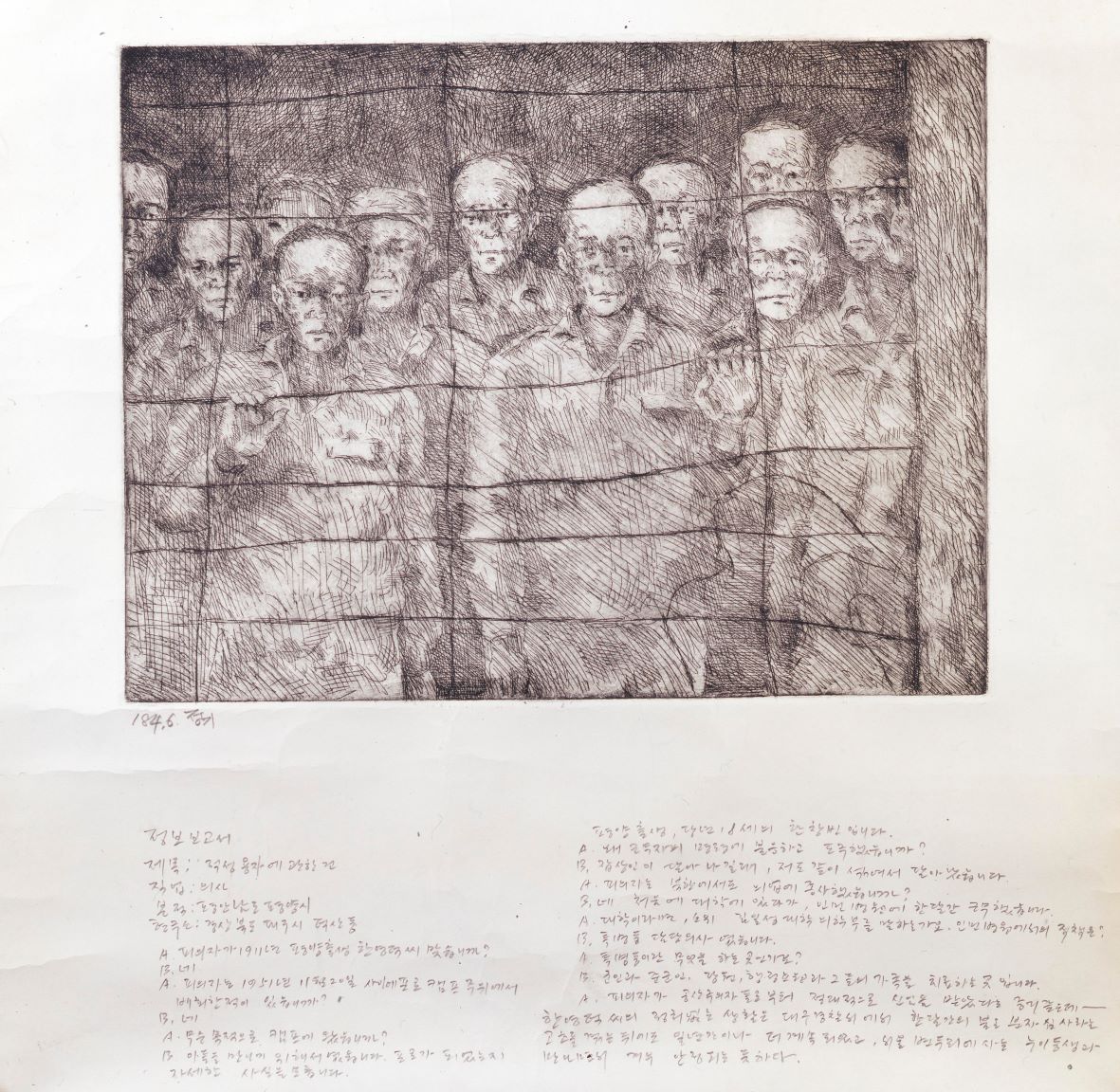
Realism
In Korea, realism was used as a critical term as well as artistic methodology. It referred to different meanings according to the three phases seen between the 1960s and the 1980s: a departure from the basic proposition “art is a reflection of reality,” raised by the Reality Group (Hyeonsil dongin) in the late 1960s; a mid-stage influenced by the artistic theory which emphasized the formal pursuit of realism within Minjung-oriented works in the 1970s; and a final stage referring to the work created within the fully fledged Minjung Art movement of the 1980s. In this context, “critical realism” refers to an artistic method executed by Korean progressive artists as well as an associated critical assessment of the ideological traditions of aestheticism and formalism. It is represented through figurative artworks that reflect a critical view of early 1980s life, to recover the power of the art as tool to portray and effect reality. Art groups, such as Reality and Utterance (Hyunsilgwa bareon) or the Gwangju Freedom Artist Association (Gwangju jayu misulin hyeopuihoe) produced numerous examples of such critical realism. In distinction, “Minjung realism” refers to an art trend that developed in the mid-1980s which sought to relocate the creation and reception of art in a broader context beyond critical realism, by combining the dynamics of cultural movements with a new artistic method. Artworks of Dureong and Citizen’s Art Schools, and the banner paintings depicting the scenes of the June Democratic Uprising and the July-August Great Labor Uprising in 1987 are all considered as examples of Minjung realism. The term “factional realism” (coined by Shim Kwanghyun) refers to an art approach which attempts to combine critical realism and people’s realism to create a scientific method for politically effective art by eliminating any formally or conceptually indeterminate aspects of the work. Finally, “progressive realism” (as proposed by Lee Youngchul) refers to a multifaceted approach to solving the diverse issues of political saliency in art and the structures and strategies of activism. All these realisms were influential within the production of Minjung Art between the late 1980s and the early 1990s.
-
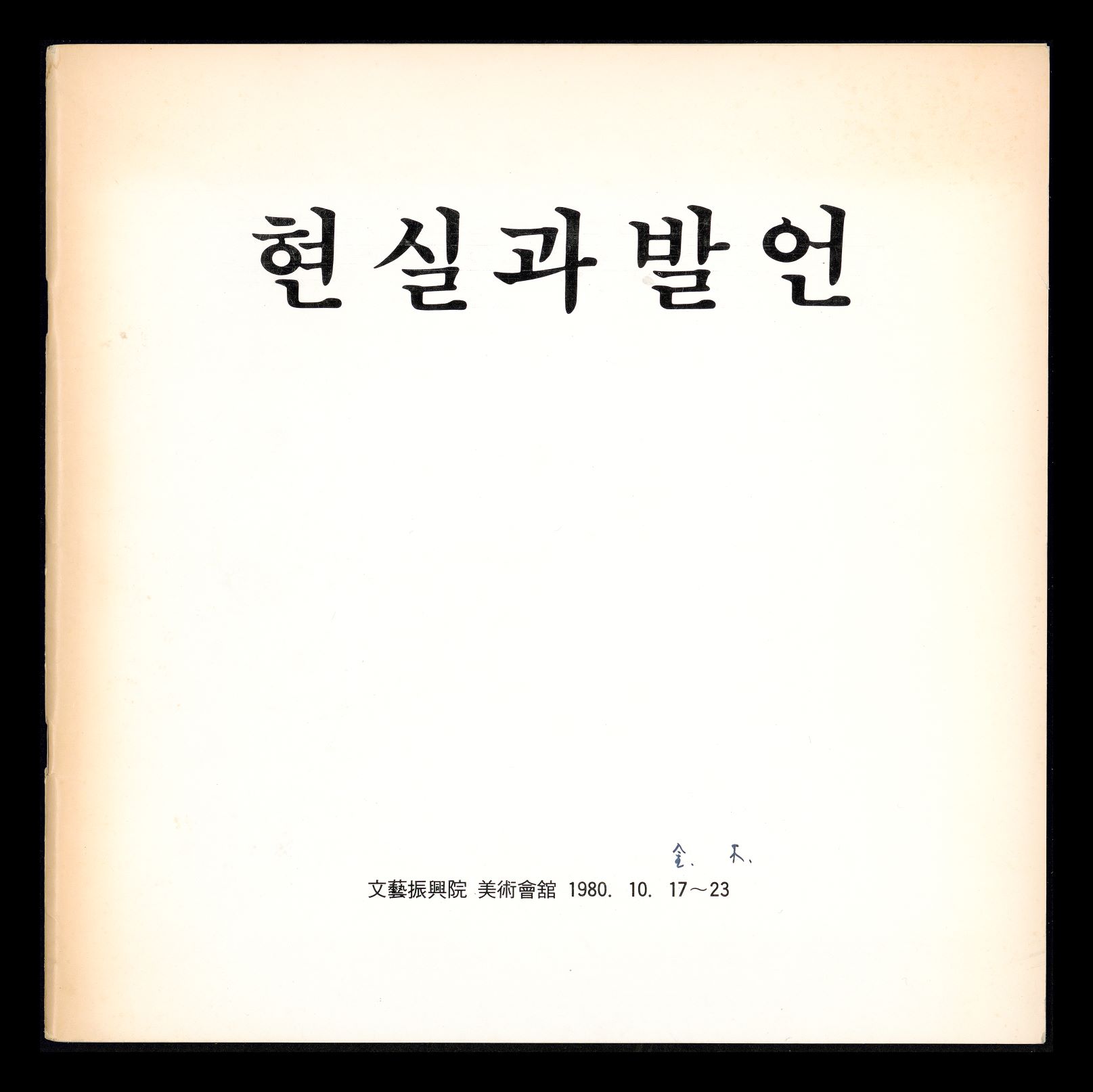
Reality and Utterance
A group formed in 1979 by artists and critics that criticized the contradictory nature of industrial society and the conservatism of the art community. The group formed during preparations for an exhibition to mark the 20th anniversary of the 1960 April Revolution. The group emphasized a realistic attitude, namely that art must depict reality and reveal the underlying contradictions of society. The group borrowed from or copied pop culture images, and also used photography, prints, comics, reproductions, and collages. Such methods were considered a means to help critically address the overabundance of visual images in contemporary Korean society, the issues of urbanization, and the colonial nature of Korean culture.
-
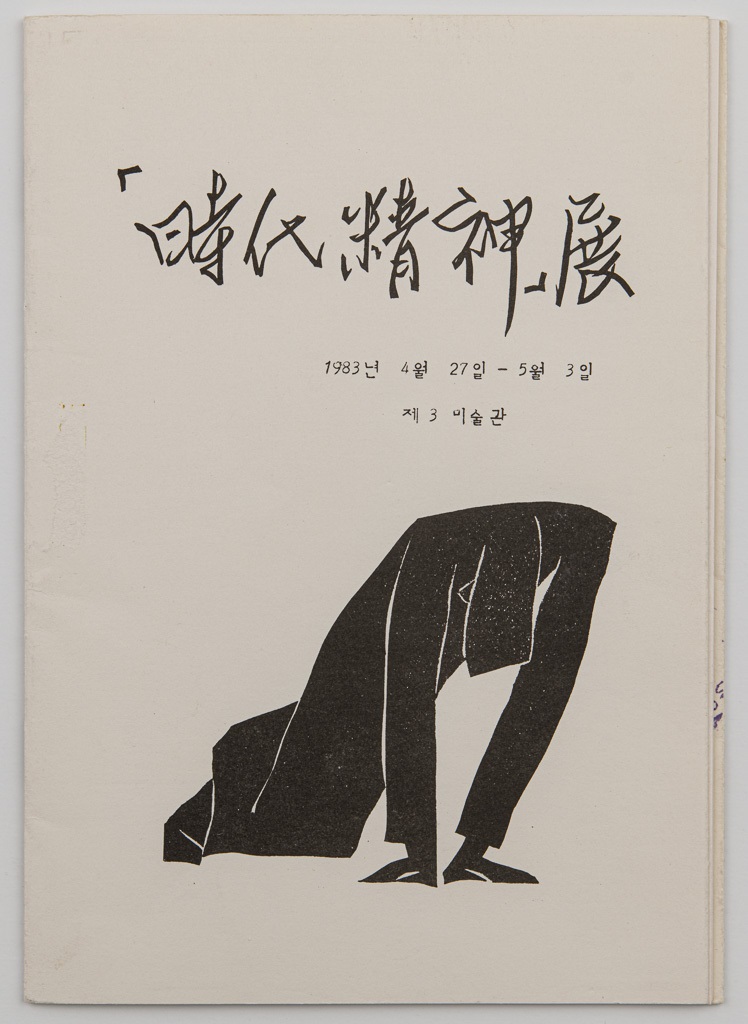
Sidaejeongsin (Zeitgeist)
Sidaejeongsin (Zeitgeist) is the first collective group formed in 1983 and remained active until 1987. In the early spring of 1983, Kim Hyeonsu, the director of the Third Museum of Art, asked Park Geon to curate an exhibition to make used of the cancelled exhibition period. Together with Moon Youngtae, Park Geon formed the Committee of Sidaejeongsin and tried a collective that gathered for exhibitions and publications and then dispersed. Moon oversaw organizing exhibitions, and Park assumed the task of publications. Moon and Park first met in April 1980 when Moon visited Park’s exhibition Strength in Busan. The two became close when Park came to Seoul and participated in exhibitions Young Minds and Traverse. Their goal was to weave together the sporadic small art movements of the early 1980s with a larger “cultural force.” Their intentions can be found in the following sentence printed in small letters on the cover of the mook (magazine-book) Sidaejeongsin: “’life’ to run toward from all directions; touch, pinch and embrace.” Park Geon stated that the spirit of an artist who sees through the times is "Zeitgeist.” In the preface of the first volume of Sidaejeongsin (Zeitgeist), the art critic Kim Yoon-Soo explained that “sidaejeongsin (zeitgeist) comes from the insight and recognition that the spirit making up our lives today is indeed in a state of corruption and irreversibility” and that “zeitgeist is the awakened spirit leading national history against all the phenomena, mindsets, institutions, and systems, all of which prevent all human beings from living a dignified life.” The first Sidaejeongsin exhibition was held in April 1983 at the Third Museum of Art. The fourteen artists who participated in the exhibition were Kang Yobae, Ko Kyeong-hun, Kim Bojung, Kim Jinyeol, Moon Youngtae, Park Geon, Park Jae-dong, Ahn Changhong, Yun Yeogeol, Lee Nagyeong, Lee Chulsoo, Lee Taeho, Jung Bocsu, and Choi Minhwa. Park Geon, who had edited textbooks at a university, edited and published the first volume of the mook Sidae jeongsin, which also served as an exhibition catalogue, in 1984. From then on, the group name, exhibition name, and mook name were collectively referred to as “Sidaejeongsin.” By 1987, they had organized a total of five exhibitions and published three volumes of the Sidaejeongsin. The theme of the first volume was “The Vitality of the Minjung Art Movement,” that of the second volume was “The Aesthetics of Liberation: Murals, Photography, Prints, and Cartoons,” and that of the third volume was “Sexuality in Our Time.” The second edition of the Sidaejeongsin exhibition traveled to Maek Gallery (Busan), Ijo Gallery (Masan), and Maekhyang Gallery (Daegu). The third edition was a print exhibition organized in collaboration with the Art School for Citizens. The fourth edition was held at Min Art Gallery, and the fifth edition was held on the theme of “what do our children draw” at the same place. In 1985, the National Art Association (Minjok misul hyeopuihoe) was established. As it published its bulletin in 1986 and Min Art Gallery, an exhibition space specializing in Minjung art was established, the Committee of Sidaejeongsin concluded its activities with the fifth exhibition. Afterwards, Moon Youngtae devoted himself to the activities of the National Art Association, and Park Geon engaged himself in the activities of the National Teachers’ Council for Democratic Education Promotion [Minju gyoyuk chujin jeonguk gyosa hyeopuihoe].






